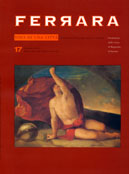During his time in Piacenza, apart from his struggle with the Ghibellines and his attendance at the first Council of Lyon, Pandoni also founded the Studio Pubblico and improved the training of clergy. After years of forced exile in Rome, he arrived in Ferrara in around 1258 in time to witness the rising power of Azzo VII d'Este and the popular endorsement of Obizzo II (1264).
His pastoral work was such that the people of Ferrara immediately took him to their hearts. It is to Pandoni that Ferrara owes the construction of the former Bishop's Palace in Via Gorgadello and the completion of the Cathedral; in 1270 he gave official approval to the cult of the Blessed Beatrice II d'Este, the daughter of Azzo VII, and shortly before his death he blessed the foundation stone of the Church of S. Domenico.
On his death in 1274 he was buried, according to his wishes, in S. Giorgio fuori le mura; in 1419 his remains were transferred to a fifteenth century sarcophagus which serves an altar table in S. Benedetto. The veneration of the Blessed Alberto Pandoni, along with that of Saint Maurelio, was revived after the arrival of the Olivetans at the church of San Giorgio (c. 1415) and after the approval of the cultus ab immemorabili tempore in the Papal decree issued by Urban VIII in 1625.
In the Latin Codex Notae et additiones ad Italiam sacram Ughelli by Johannes Hyacinthus Sbaralea (1687-1764), we learn that official consent for Pandoni's veneration reached the Olivetan monks of S. Giorgio fuori le mura on 5 September 1734, and was solemnly celebrated. In 1734, too, under the abbothood of the Reverend Ignazio Antonelli, permission was given to remove a piece of bone from the sepulchre to provide a relic for public devotions on his Feast day. This took place on 2 September 1734, a Sunday, with the exposition of the silver statue and the Blessed Pandoni's relic on the high altar.
Cardinal Tommaso Ruffo was bishop of Ferrara from 1717 to 1738. Ruffo's time as bishop stands out by virtue of his strong personality: he was a bishop of great determination, a politician and a lover of the arts. Ruffo, who had a liking for celebrations and processions, and was well aware of the importance of local and popular devotions, encouraged the cult of Pandoni by staging solemn festivals.



